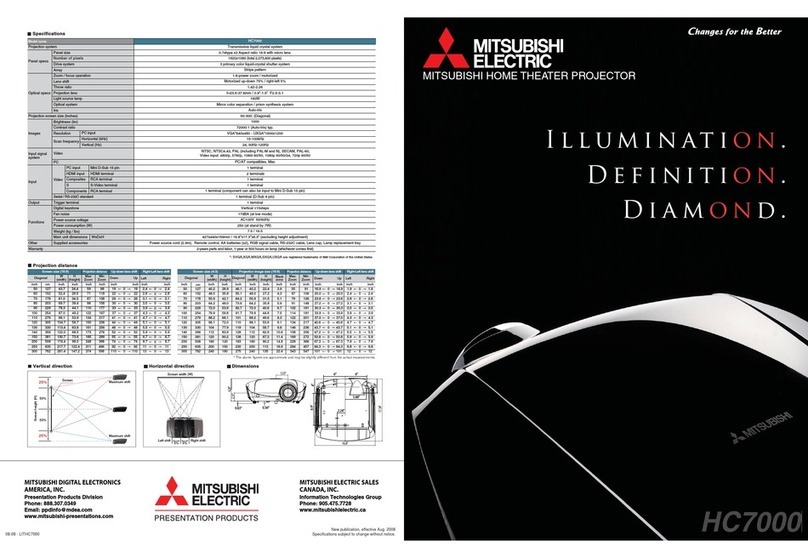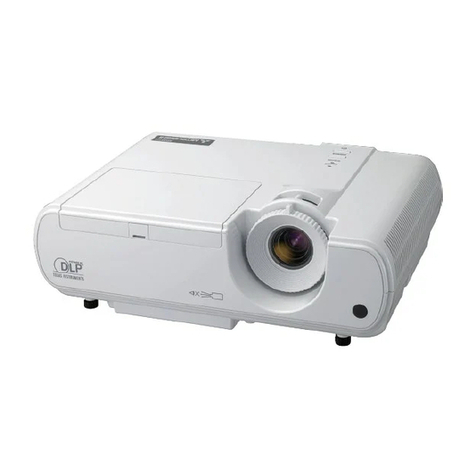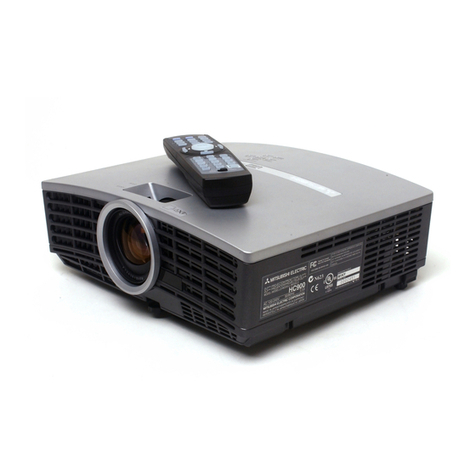Compared to conventional glass-substrate liquid-crystal panels that project
images by passing backlight through them, reflective full-high-definition
SXRD™ panels are made of a silicon substrate with a liquid-crystal coating,
and images are reproduced by reflecting the light. The development of
Normally black mode and an advanced
panel processing technology has
enabled higher brightness and contrast
and high-speed response to be realized.
Movies and other images such as those
of digital high-definition broadcasts are
reproduced naturally and with distinct
clarity.
Each of the primary colors
(Red, Green and Blue, RGB)
is processed by a separate
reflective liquid-crystal panel
to realize full-high-definition
resolution. The lighting from
each panel is merged at
the optical block and then
projected, resulting in
the reproduction of truly
natural colors with excellent
alignment and no mixing of
pixel colors.
Sharp, Smooth Reproduction of Fast-moving Images
Reflective Full-high-definition SXRD™ Panels* Incorporated
The space between pixels has been reduced to 0.2µm, a smaller gap than
previously used, and the structure between pixels has been optimized to
reduce crosstalk. Additionally, a 94% high aperture ratio has been achieved,
making the grid pattern*, which commonly becomes more prominent as
screen size increases, hardly noticeable. As a result, the original smooth
texture of moving images is beautifully expressed.
Negligible Grid Pattern Ensures Clearer Images on Large Screens
In addition to providing high contrast image reproduction, the newly
developed optical compensator significantly reduces light lost during
processing. The 18-step fixed aperture can be adjusted freely, improving
the reproduction of blacks. When the Iris is closed, we have realized black
color darker than before resulting in a maximum contrast of 150,000:1.
Motion vector analysis technology is applied for highly accurate frame
alignment using preceding and following images. This compensation
function creates the optimal number of frames for the content, reducing
distortion in all directions: vertically, laterally and diagonally.
Built-in Frame Rate Convertor (FRC)
Compensation Ensures Optimal Frame Number for Contents
A key element in projector performance is the lens. The lens incorporated
in the HC9000D has a 6-piece/17-cluster structure including a high-end,
extra-low dispersion (ED) lens with advanced functionality compared to
standard glass lenses. Peripheral focusing performance is improved, and
chromatic aberration and color mixing are reduced to a minimum.
New Built-in 1.8x Power Zoom Lens
Compatible with Full-high-definition Resolution
Cinema Filter increases the purity of green in
particular, realizing vivid expression of
the greens such those in the scene of a
deeply forested hillside. Further, by expanding
the green and cyan spectrums, cinema-like
image reproduction is achieved.
Built-in Cinema Filter Function
Enhanced Depth and Clarity
Color Management allows the independent adjustment of Hue,
Saturation, Gain for R (Red), G (Green), B (Blue), C (Cyan), M
(Magenta) and Y (Yellow). Subtle color adjustment is possible, enabling
content to be enjoyed in color tones matched to the user’s preference.
Color Management Function
Adjust Color to Suit Preferences
The resolution of the content delivered by the projector varies widely, from
Blu-ray (1,920 ×1,080) to DVD (720×480) and other formats.
In the case of DVDs, the content must be converted to 1,920×1,080, and
the higher the conversion precision, the better the image quality.
This is performed using an IC (manufactured by IDT) highly evaluated for its
image-processing performance.
Processing such as highly precise
interlace/progressive (I/P)
conversion and scaling allows
formats such as DVD, and of course
full-high-definition content, to be
reproduced with high picture quality.
High-performance Processor
Manufactured by Integrated Device Technology Inc. (IDT) (previously Silicon Optix Inc.)
Cutting-edge, Full-high-definition Technologies Ensure Finely
Textured Images and Infinite Expressive Power
Transmissive liquid-crystal panel
Contrast ratio of 150,000:1
Contrast ratio of 70,000:1
Reflective liquid-crystal panel
Conventional Reflective liquid-crystal panel
ED glass lens
C
A C DB
A E
CA DB GE H
F
A
A A F F F
A F
A FB C D E G H I J
Tru e Film Mode:
Crystal-clear images are projected while maintaining the sensation
of a film-based source.
True Video Mode:
Motion compensation of video images suppresses video distortion.
Off (twice the speed of film and other formats) :
A 96Hz driver provides four times the input of 24P, realizing a speed
twice that of film and other formats. Conversion eliminates delays,
making it an ideal mode for video games.
*1,920×1,080 pixels (horizontal × vertical)
*Both rise and fall times.
*Visible lattice due to gaps between pixels.
The liquid-crystal cell thickness has been reduced to under 2µm, enabling
a quick response speed of 2ms. Even at times of momentary color changes
or fast-moving images, exquisitely clear scenes with minimal blurring can
be enjoyed.
High-speed 2ms* Response for Clear Projection of Scenes with
Fast-moving Images
Separate Reflective Liquid-crystal Panels for Each Primary Color
Impressive High Contrast Ratio Up to 150,000:1
New frames are created from preceding /following images
60-frame images (e.g., T V broadcasts)
60-frame movie images
24-frame images (e.g., BD/ DVD software)
Input signal
Input signal
Input signal
True Video
Mode:
Twice the
speed of film
Tru e Film
Mode
1/60s
1/60s
1/24s
1/96s1/120s
1/120s
Images interpolated, 120 frames/s displayed
Images interpolated, 120 frames/s displayed
Image signal with 2-3 pull-down correction
Images converted to original 24 frames
Images interpolated, 96 frames/s displayed
Conventional
Fast movemen t is blurr ed
HC9000D
Fast movemen t is displ ayed clearly
Before adjustment After adjustment
* SXRD™ and the SXRD™ logo are registered trademar ks of Sony Cor poration.
Wire grid
Wire grid
Wire grid
Wire grid
Optical
compensator
Optical
compensator
Optical
compensator
NEW
HC9000D
*Images used for explaining effects of featured functions.
3D













































